Lumican/Lumikine Promotes Healing of Corneal Epithelium Debridement by Upregulation of EGFR Ligand Expression via Noncanonical Smad-Independent TGFβ/TBRs Signaling
Abstract
1. Introduction
2. Materials and Methods
2.1. Animal Maintenance and Corneal Epithelium Debridement Wound In Vivo
2.2. Quantitative Real Time PCR (qRT-PCR) of EGFR Ligands
2.3. Immunofluorescence Staining for EGFR-1068 and -1069-Phosphorylated Tyrosine
2.4. Inhibition of Lumikine Effects on Epithelium Wound Healing by Anti-TGFβ and Anti-EREG Antibodies
2.5. Statistical Analysis
3. Results
3.1. Effects of Antibody against TGFβ on the Activity of Lumikine (LumC13C-A) in the Healing of Corneal Epithelium Debridement (CED)
3.2. Identification of the Minimum/Essential LumC-Terminal Domain for Promoting Corneal Epithelium Wound Healing
3.3. Identification of the Y Residue as Integral for Lumikine in the Healing of CED
3.4. Identification of Downstream Signaling Pathway(s) Triggered by Lum/Lumikine
3.5. Effects of Lumikine on the Expression of EGFR Ligands
4. Discussion
Supplementary Materials
Author Contributions
Funding
Institutional Review Board Statement
Informed Consent Statement
Data Availability Statement
Conflicts of Interest
References
- Massagué, J.; Sheppard, D. TGF-β signaling in health and disease. Cell 2023, 186, 4007–4037. [Google Scholar] [CrossRef] [PubMed]
- Ogata, F.T.; Verma, S.; Coulson-Thomas, V.J.; Gesteira, T.F. TGF-β-Based Therapies for Treating Ocular Surface Disorders. Cells 2024, 13, 1105. [Google Scholar] [CrossRef] [PubMed]
- Vander Ark, A.; Cao, J.; Li, X. TGF-β receptors: In and beyond TGF-β signaling. Cell. Signal. 2018, 52, 112–120. [Google Scholar] [CrossRef]
- Tzavlaki, K.; Moustakas, A. TGF-β Signaling. Biomolecules 2020, 10, 487. [Google Scholar] [CrossRef]
- Gesteira, T.F.; Verma, S.; Coulson Thomas, V.J. Small leucine rich proteoglycans: Biology, function and their therapeutic potential in the ocular surface. Ocul. Surf. 2023, 29, 521–536. [Google Scholar] [CrossRef]
- Kao, W.W.-Y.; Funderburgh, J.L.; Xia, Y.; Liu, C.-Y.; Conrad, G.W. Focus on molecules: Lumican. Exp. Eye Res. 2006, 82, 3–4. [Google Scholar] [CrossRef] [PubMed]
- Seomun, Y.; Joo, C.K. Lumican induces human corneal epithelial cell migration and integrin expression via ERK 1/2 signaling. Biochem. Biophys. Res. Commun. 2008, 372, 221–225. [Google Scholar] [CrossRef]
- Kao, W.W.-Y.; Liu, C.-Y. Roles of lumican and keratocan on corneal transparency. Glycoconj. J. 2002, 19, 275–285. [Google Scholar] [CrossRef]
- Saika, S.; Shiraishi, A.; Saika, S.; Liu, C.Y.; Funderburgh, J.L.; Kao, C.W.C.; Converse, R.L.; Kao, W.W.-Y. Role of Lumican in the Corneal Epithelium during Wound Healing. J. Biol. Chem. 2000, 275, 2607–2612. [Google Scholar] [CrossRef]
- Chakravarti, S.; Petroll, W.M.; Hassell, J.R.; Jester, J.V.; Lass, J.H.; Paul, J.; Birk, D.E. Corneal opacity in lumican-null mice: Defects in collagen fibril structure and packing in the posterior stroma. Investig. Ophthalmol. Vis. Sci. 2000, 41, 3365–3373. [Google Scholar]
- Kao, W.W.-Y. Ocular surface tissue morphogenesis in normal and disease States revealed by genetically modified mice. Cornea 2006, 25 (Suppl. S1), S7–S19. [Google Scholar] [CrossRef] [PubMed]
- Carlson, E.C.; Lin, M.; Liu, C.-Y.; Kao, W.W.-Y.; Perez, V.L.; Pearlman, E. Keratocan and Lumican Regulate Neutrophil Infiltration and Corneal Clarity in Lipopolysaccharide-induced Keratitis by Direct Interaction with CXCL1. J. Biol. Chem. 2007, 282, 35502–35509. [Google Scholar] [CrossRef]
- Carlson, E.C.; Sun, Y.; Auletta, J.; Kao, W.W.; Liu, C.-Y.; Perez, V.L.; Pearlman, E. Regulation of corneal inflammation by neutrophil-dependent cleavage of keratan sulfate proteoglycans as a model for breakdown of the chemokine gradient. J. Leukoc. Biol. 2010, 88, 517–522. [Google Scholar] [CrossRef] [PubMed]
- Hayashi, Y.; Call, M.K.; Chikama, T.-I.; Liu, H.; Carlson, E.C.; Sun, Y.; Pearlman, E.; Funderburgh, J.L.; Babcock, G.; Liu, C.-Y.; et al. Lumican is required for neutrophil extravasation following corneal injury and wound healing. J. Cell Sci. 2010, 123, 2987–2995. [Google Scholar] [CrossRef]
- Sivaraman, K.; Shanthi, C. Matrikines for therapeutic and biomedical applications. Life Sci. 2018, 214, 22–33. [Google Scholar] [CrossRef] [PubMed]
- Karamanou, K.; Franchi, M.; Proult, I.; Rivet, R.; Vynios, D.; Brézillon, S. Lumican Inhibits In Vivo Melanoma Metastasis by Altering Matrix-Effectors and Invadopodia Markers. Cells 2021, 10, 841. [Google Scholar] [CrossRef] [PubMed]
- Wu, F.; Chakravarti, S. Differential expression of inflammatory and fibrogenic genes and their regulation by NF-kappaB inhibition in a mouse model of chronic colitis. J. Immunol. 2007, 179, 6988–7000. [Google Scholar] [CrossRef]
- Wu, F.; Vij, N.; Roberts, L.; Lopez-Briones, S.; Joyce, S.; Chakravarti, S. A novel role of the lumican core protein in bacterial lipopolysaccharide-induced innate immune response. J. Biol. Chem. 2007, 282, 26409–26417. [Google Scholar] [CrossRef]
- Lohr, K.; Sardana, H.; Lee, S.; Wu, F.; Huso, D.L.; Hamad, A.R.; Chakravarti, S. Extracellular matrix protein lumican regulates inflammation in a mouse model of colitis. Inflamm. Bowel Dis. 2012, 18, 143–151. [Google Scholar] [CrossRef]
- Jariwala, N.; Ozols, M.; Bell, M.; Bradley, E.; Gilmore, A.; Debelle, L.; Sherratt, M.J. Matrikines as mediators of tissue remodelling. Adv. Drug Deliv. Rev. 2022, 185, 114240. [Google Scholar] [CrossRef]
- Moreth, K.; Iozzo, R.V.; Schaefer, L. Small leucine-rich proteoglycans orchestrate receptor crosstalk during inflammation. Cell Cycle 2012, 11, 2084–2091. [Google Scholar] [CrossRef] [PubMed]
- Feugaing, D.D.S.; Tammi, R.; Echtermeyer, F.G.; Stenmark, H.; Kresse, H.; Smollich, M.; Schönherr, E.; Kiesel, L.; Götte, M. Endocytosis of the dermatan sulfate proteoglycan decorin utilizes multiple pathways and is modulated by epidermal growth factor receptor signaling. Biochimie 2007, 89, 637–657. [Google Scholar] [CrossRef] [PubMed]
- Götte, M.; Kresse, H.; Hausser, H. Endocytosis of decorin by bovine aortic endothelial cells. off. Eur. J. Cell Biol. 1995, 66, 226–233. [Google Scholar] [PubMed]
- Schaefer, L.; Gröne, H.-J.; Raslik, I.; Robenek, H.; Ugorcakova, J.; Budny, S.; Schaefer, R.M.; Kresse, H. Small proteoglycans of normal adult human kidney: Distinct expression patterns of decorin, biglycan, fibromodulin, and lumican. Kidney Int. 2000, 58, 1557–1568. [Google Scholar] [CrossRef]
- Zhu, J.-X.; Goldoni, S.; Bix, G.; Owens, R.T.; McQuillan, D.J.; Reed, C.C.; Iozzo, R.V. Decorin Evokes Protracted Internalization and Degradation of the Epidermal Growth Factor Receptor via Caveolar Endocytosis. J. Biol. Chem. 2005, 280, 32468–32479. [Google Scholar] [CrossRef]
- Buraschi, S.; Neill, T.; Goyal, A.; Poluzzi, C.; Smythies, J.; Owens, R.T.; Schaefer, L.; Torres, A.; Iozzo, R.V. Decorin causes autophagy in endothelial cells via Peg3. Proc. Natl. Acad. Sci. USA 2013, 110, E2582–E2591. [Google Scholar] [CrossRef]
- Wells, A.; Marti, U. Signalling shortcuts: Cell-surface receptors in the nucleus? Nat. Rev. Mol. Cell Biol. 2002, 3, 697–702. [Google Scholar] [CrossRef]
- Bryant, D.M.; Stow, J.L. Nuclear Translocation of Cell-Surface Receptors: Lessons from Fibroblast Growth Factor. Traffic 2005, 6, 947–953. [Google Scholar] [CrossRef]
- Wang, S.-C.; Hung, M.-C. Nuclear translocation of the epidermal growth factor receptor family membrane tyrosine kinase receptors. Clin. Cancer Res. 2009, 15, 6484–6489. [Google Scholar] [CrossRef]
- Coulson-Thomas, V.J.; Coulson-Thomas, Y.M.; Gesteira, T.F.; Andrade de Paula, C.A.; Carneiro, C.R.; Ortiz, V.; Toma, L.; Kao, W.W.-Y.; Nader, H.B. Lumican expression, localization and antitumor activity in prostate cancer. Exp. Cell Res. 2013, 319, 967–981. [Google Scholar] [CrossRef]
- Carlson, E.C.; Liu, C.-Y.; Chikama, T.-I.; Hayashi, Y.; Kao, C.W.-C.; Birk, D.E.; Funderburgh, J.L.; Jester, J.V.; Kao, W.W.-Y. Keratocan, a cornea-specific keratan sulfate proteoglycan, is regulated by lumican. J. Biol. Chem. 2005, 280, 25541–25547. [Google Scholar] [CrossRef] [PubMed]
- Karamanou, K.; Franchi, M.; Onisto, M.; Passi, A.; Vynios, D.H.; Brézillon, S. Evaluation of lumican effects on morphology of invading breast cancer cells, expression of integrins and downstream signaling. FEBS J. 2020, 287, 4862–4880. [Google Scholar] [CrossRef] [PubMed]
- Schaefer, L.; Tredup, C.; Gubbiotti, M.A.; Iozzo, R.V. Proteoglycan neofunctions: Regulation of inflammation and autophagy in cancer biology. FEBS J. 2017, 284, 10–26. [Google Scholar] [CrossRef]
- Wells, A.; Nuschke, A.; Yates, C.C. Skin tissue repair: Matrix microenvironmental influences. Matrix Biol. 2016, 49, 25–36. [Google Scholar] [CrossRef] [PubMed]
- Yeh, L.-K.; Chen, W.-L.; Li, W.; Espana, E.M.; Ouyang, J.; Kawakita, T.; Kao, W.W.-Y.; Tseng, S.C.G.; Liu, C.-Y. Soluble lumican glycoprotein purified from human amniotic membrane promotes corneal epithelial wound healing. Investig. Opthalmol. Vis. Sci. 2005, 46, 479–486. [Google Scholar] [CrossRef]
- Yeh, J.-T.; Yeh, L.-K.; Jung, S.-M.; Chang, T.-J.; Wu, H.-H.; Shiu, T.-F.; Liu, C.-Y.; Kao, W.-Y.; Chu, P.-H. Impaired skin wound healing in lumican-null mice. Br. J. Dermatol. 2010, 163, 1174–1180. [Google Scholar] [CrossRef]
- Meij, J.T.; Carlson, E.C.; Wang, L.; Liu, C.Y.; Jester, J.V.; Birk, D.E.; Kao, W.W. Targeted expression of a lumican transgene rescues corneal deficiencies in lumican-null mice. Mol. Vis. 2007, 13, 2012–2018. [Google Scholar]
- Maiti, G.; Frikeche, J.; Lam, C.Y.-M.; Biswas, A.; Shinde, V.; Samanovic, M.; Kagan, J.C.; Mulligan, M.J.; Chakravarti, S. Matrix lumican endocytosed by immune cells controls receptor ligand trafficking to promote TLR4 and restrict TLR9 in sepsis. Proc. Natl. Acad. Sci. USA 2021, 118, e2100999118. [Google Scholar] [CrossRef]
- Maiti, G.; Ashworth, S.; Choi, T.; Chakravarti, S. Molecular cues for immune cells from small leucine-rich repeat proteoglycans in their extracellular matrix-associated and free forms. Matrix Biol. 2023, 123, 48–58. [Google Scholar] [CrossRef]
- Yamanaka, O.; Yuan, Y.; Coulson-Thomas, V.J.; Gesteira, T.F.; Call, M.K.; Zhang, Y.; Zhang, J.; Chang, S.-H.; Xie, C.; Liu, C.-Y.; et al. Lumican Binds ALK5 to Promote Epithelium Wound Healing. PLoS ONE 2013, 8, e82730. [Google Scholar] [CrossRef]
- Gesteira, T.F.; Coulson-Thomas, V.J.; Yuan, Y.; Zhang, J.; Nader, H.B.; Kao, W.W.-Y. Lumican Peptides: Rational Design Targeting ALK5/TGFBRI. Sci. Rep. 2017, 7, 42057. [Google Scholar] [CrossRef] [PubMed]
- Verma, S.; Ogata, F.T.; Moreno, I.Y.; Prinholato da Silva, C.; Marforio, T.D.; Calvaresi, M.; Sen, M.; Coulson-Thomas, V.J.; Gesteira, T.F. Rational design and synthesis of lumican stapled peptides for promoting corneal wound healing. Ocul. Surf. 2023, 30, 168–178. [Google Scholar] [CrossRef]
- Terai, K.; Call, M.K.; Liu, H.; Saika, S.; Liu, C.Y.; Hayashi, Y.; Chikama, T.-I.; Zhang, J.; Terai, N.; Kao, C.W.C.; et al. Crosstalk between TGF-β and MAPK Signaling during Corneal Wound Healing. Investig. Ophthalmol. Vis. Sci. 2011, 52, 8208–8215. [Google Scholar] [CrossRef] [PubMed]
- Zhang, L.; Wang, W.; Hayashi, Y.; Jester, J.V.; Birk, D.E.; Gao, M.; Liu, C.-Y.; Kao, W.W.-Y.; Karin, M.; Xia, Y. A role for MEK kinase 1 in TGF-beta/activin-induced epithelium movement and embryonic eyelid closure. EMBO J. 2003, 22, 4443–4454. [Google Scholar] [CrossRef]
- Cheng, M.F.; Abdullah, F.S.; Buechler, M.B. Essential growth factor receptors for fibroblast homeostasis and activation: Fibroblast Growth Factor Receptor (FGFR), Platelet Derived Growth Factor Receptor (PDGFR), and Transforming Growth Factor β Receptor (TGFβR). F1000Research 2024, 13, 120. [Google Scholar] [CrossRef] [PubMed]
- Saika, S.; Okada, Y.; Miyamoto, T.; Yamanaka, O.; Ohnishi, Y.; Ooshima, A.; Liu, C.-Y.; Weng, D.; Kao, W.W.-Y. Role of p38 MAP kinase in regulation of cell migration and proliferation in healing corneal epithelium. Investig. Opthalmol. Vis. Sci. 2004, 45, 100–109. [Google Scholar] [CrossRef] [PubMed]
- Hutcheon, A.E.K.; Guo, X.Q.; Stepp, M.A.; Simon, K.J.; Weinreb, P.H.; Violette, S.M.; Zieske, J.D. Effect of wound type on Smad 2 and 4 translocation. Investig. Opthalmol. Vis. Sci. 2005, 46, 2362–2368. [Google Scholar] [CrossRef]
- Leu, T.-H.; Maa, M.-C. Functional implication of the interaction between EGF receptor and c-Src. Front. Biosci. 2003, 8, s28–s38. [Google Scholar] [CrossRef]
- Yakymovych, I.; Yakymovych, M.; Hamidi, A.; Landström, M.; Heldin, C.-H. The type II TGF-β receptor phosphorylates Tyr182 in the type I receptor to activate downstream Src signaling. Sci. Signal. 2022, 15, eabp9521. [Google Scholar] [CrossRef]
- Draper, B.K.; Komurasaki, T.; Davidson, M.K.; Nanney, L.B. Topical epiregulin enhances repair of murine excisional wounds. Wound Repair Regen. 2003, 11, 188–197. [Google Scholar] [CrossRef]
- Zhang, Y.; Kobayashi, T.; Hayashi, Y.; Yoshioka, R.; Shiraishi, A.; Shirasawa, S.; Higashiyama, S.; Ohashi, Y. Important role of epiregulin in inflammatory responses during corneal epithelial wound healing. Investig. Opthalmol. Vis. Sci. 2012, 53, 2414–2423. [Google Scholar] [CrossRef] [PubMed]
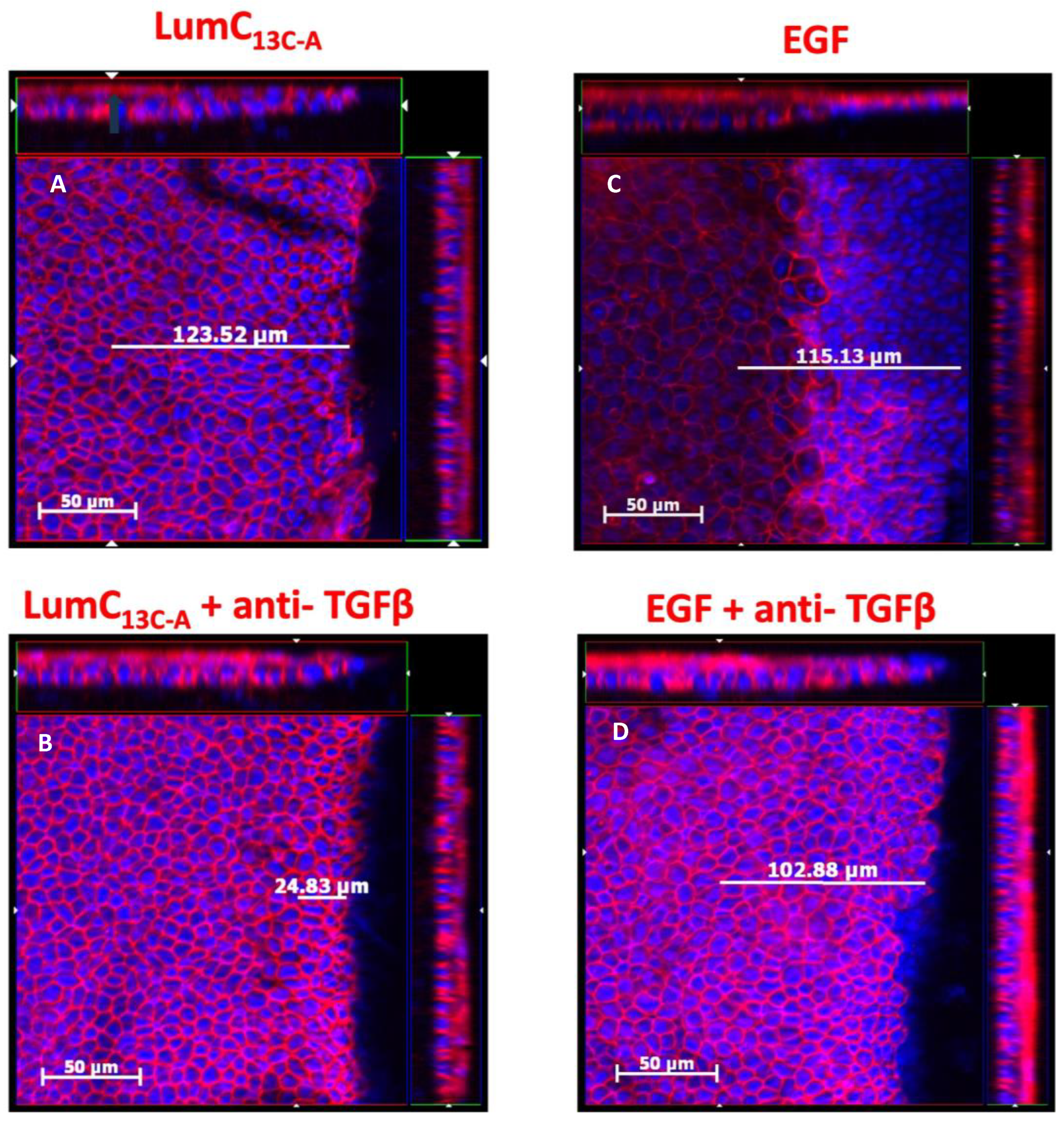
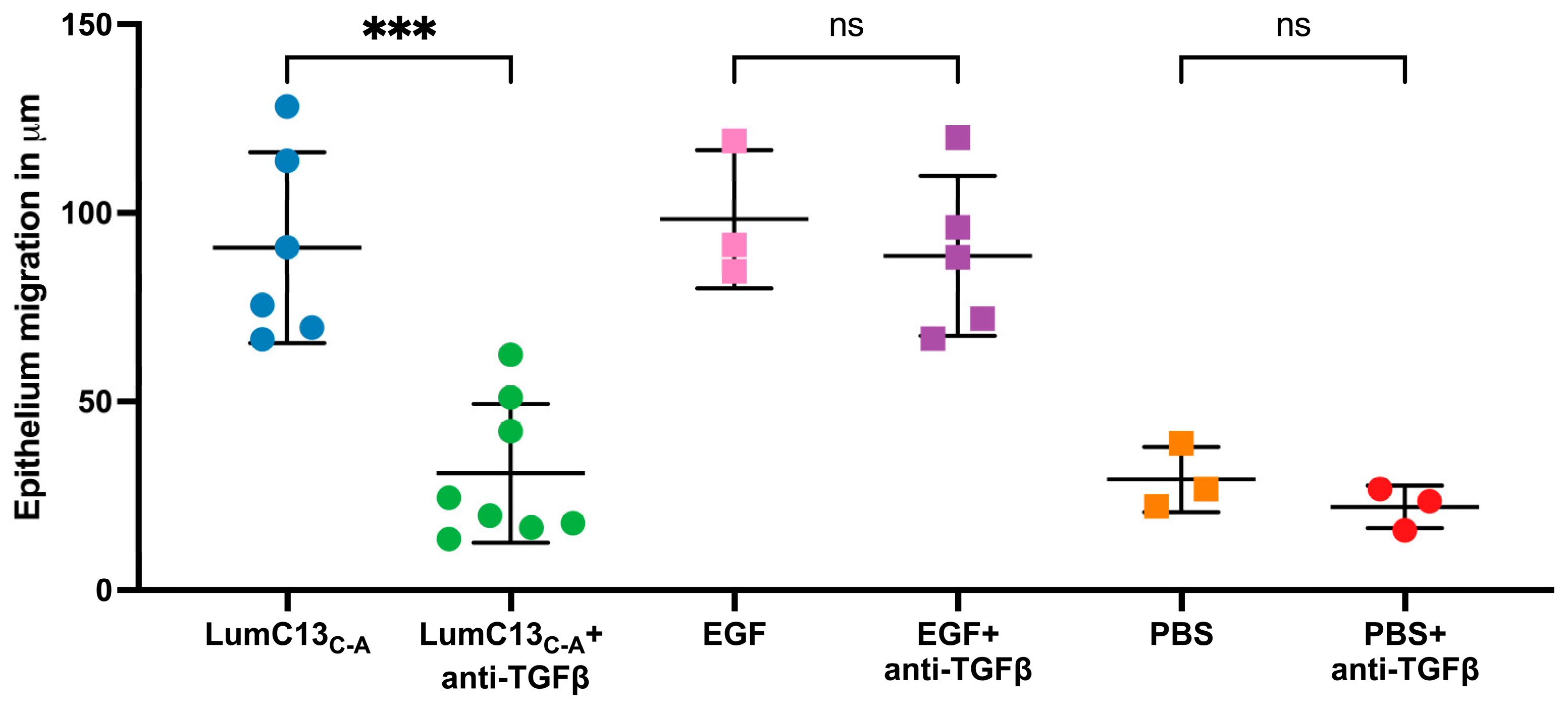
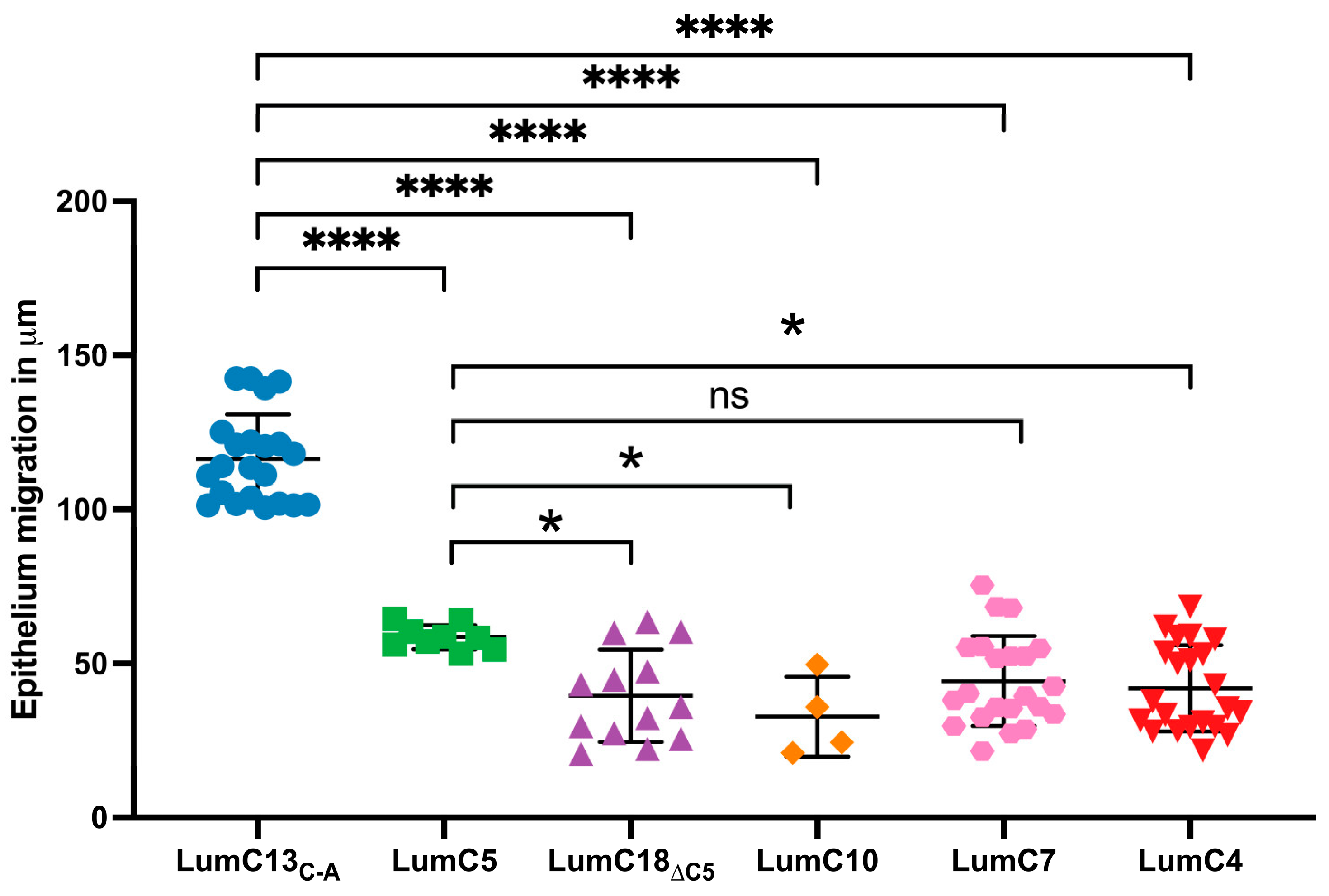
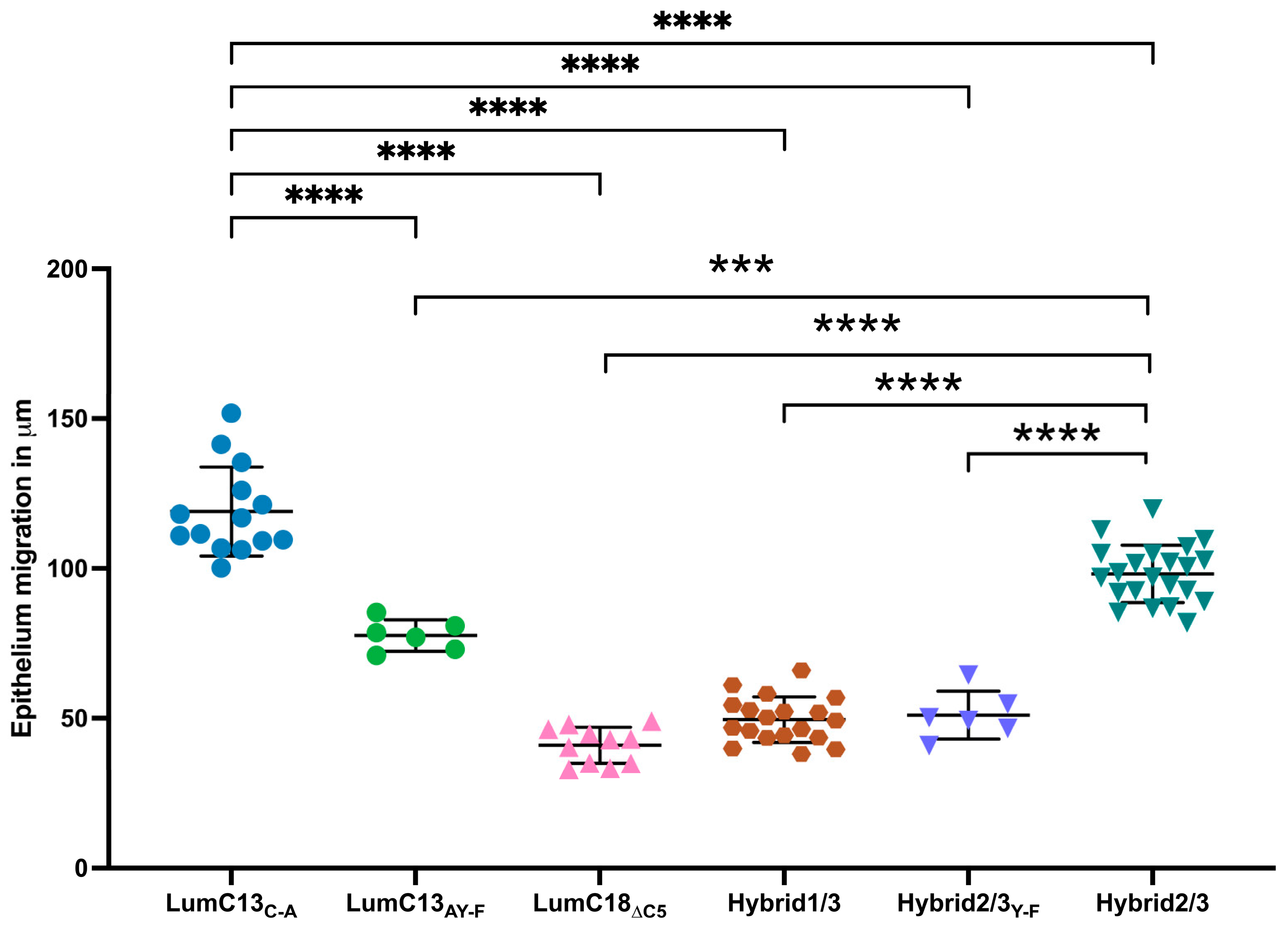
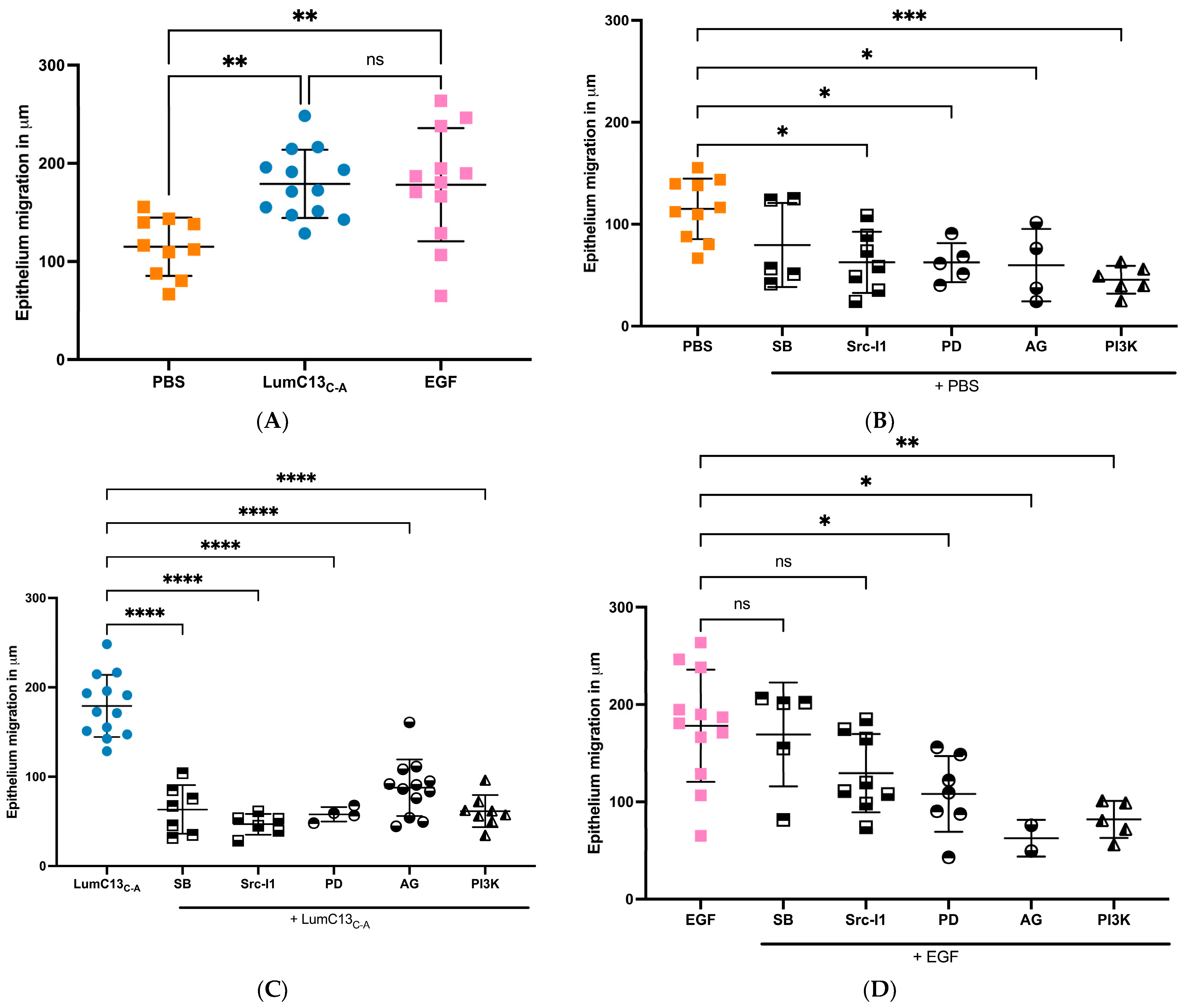
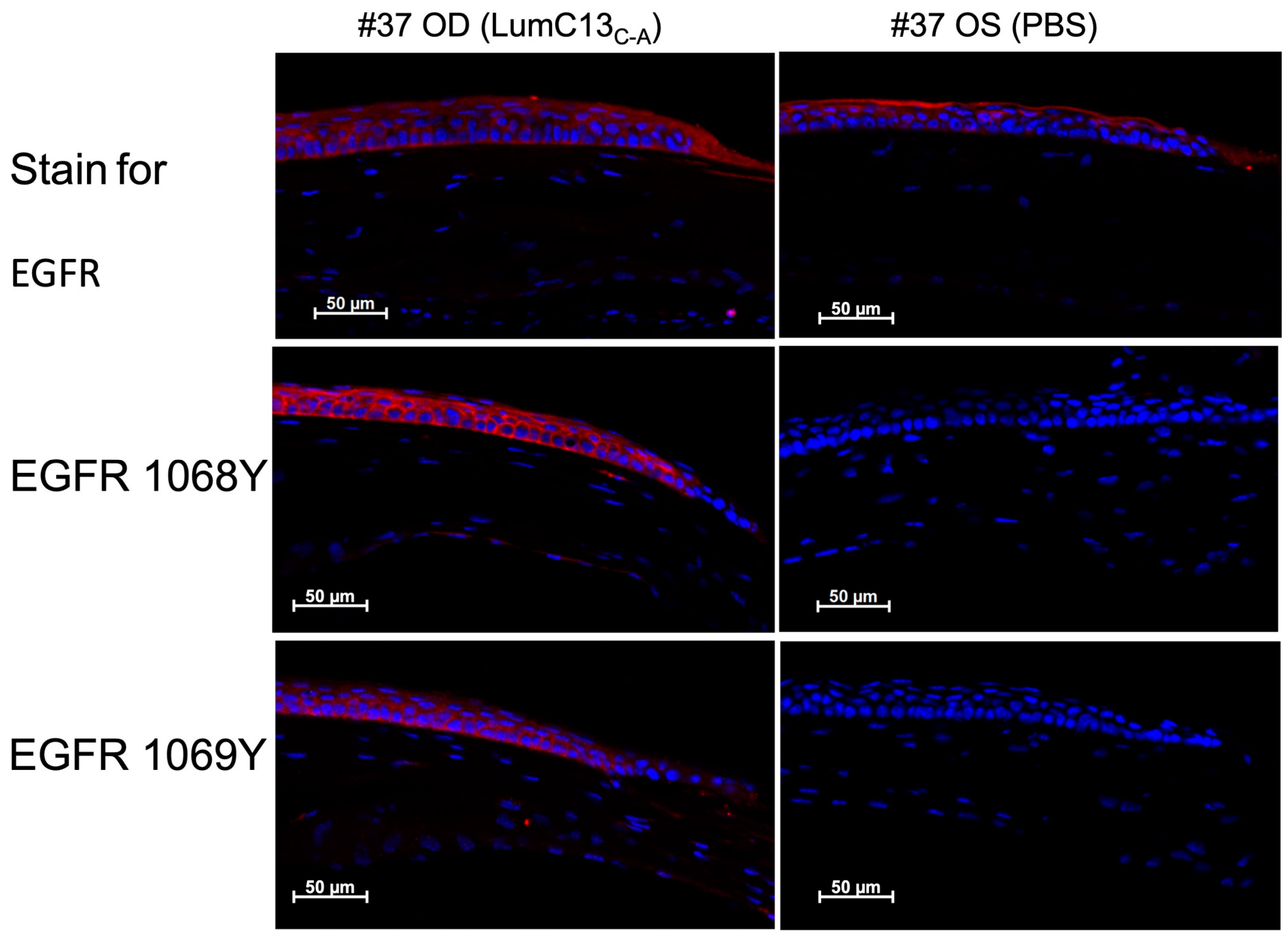
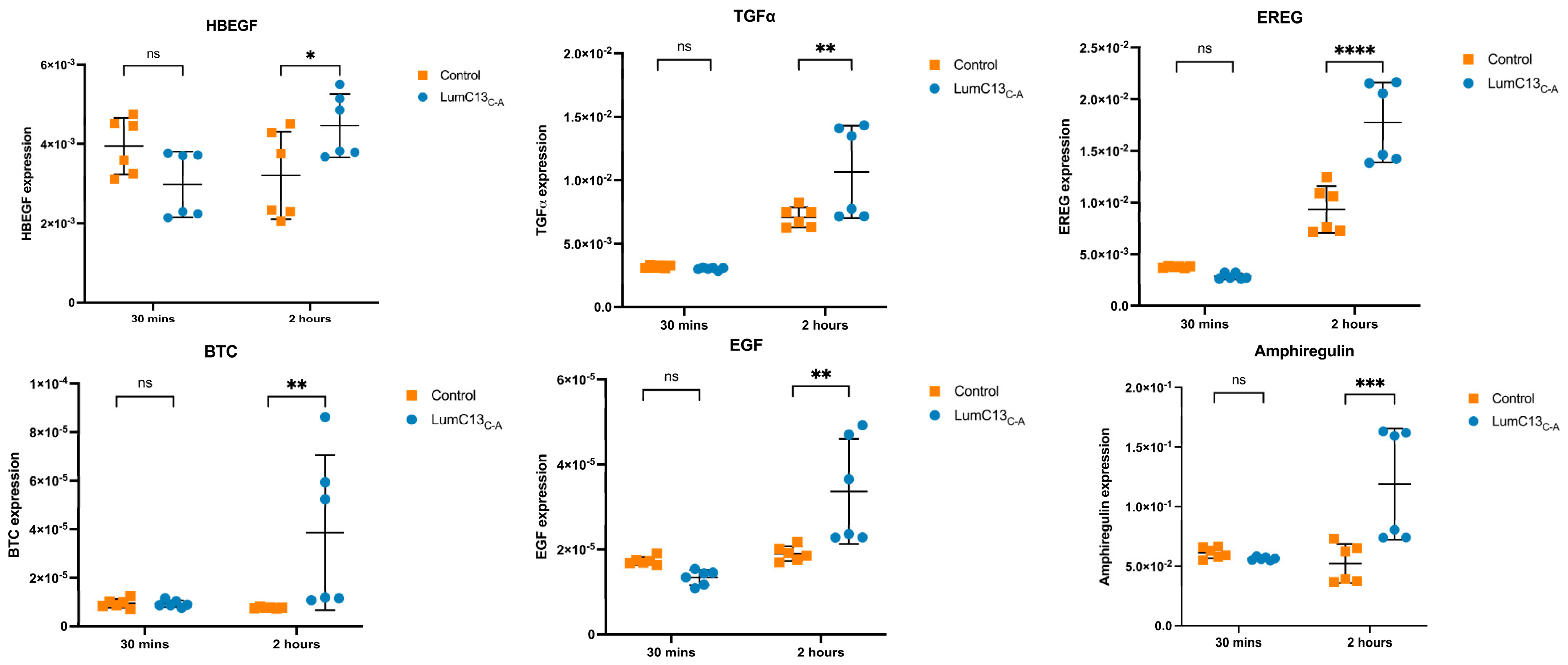
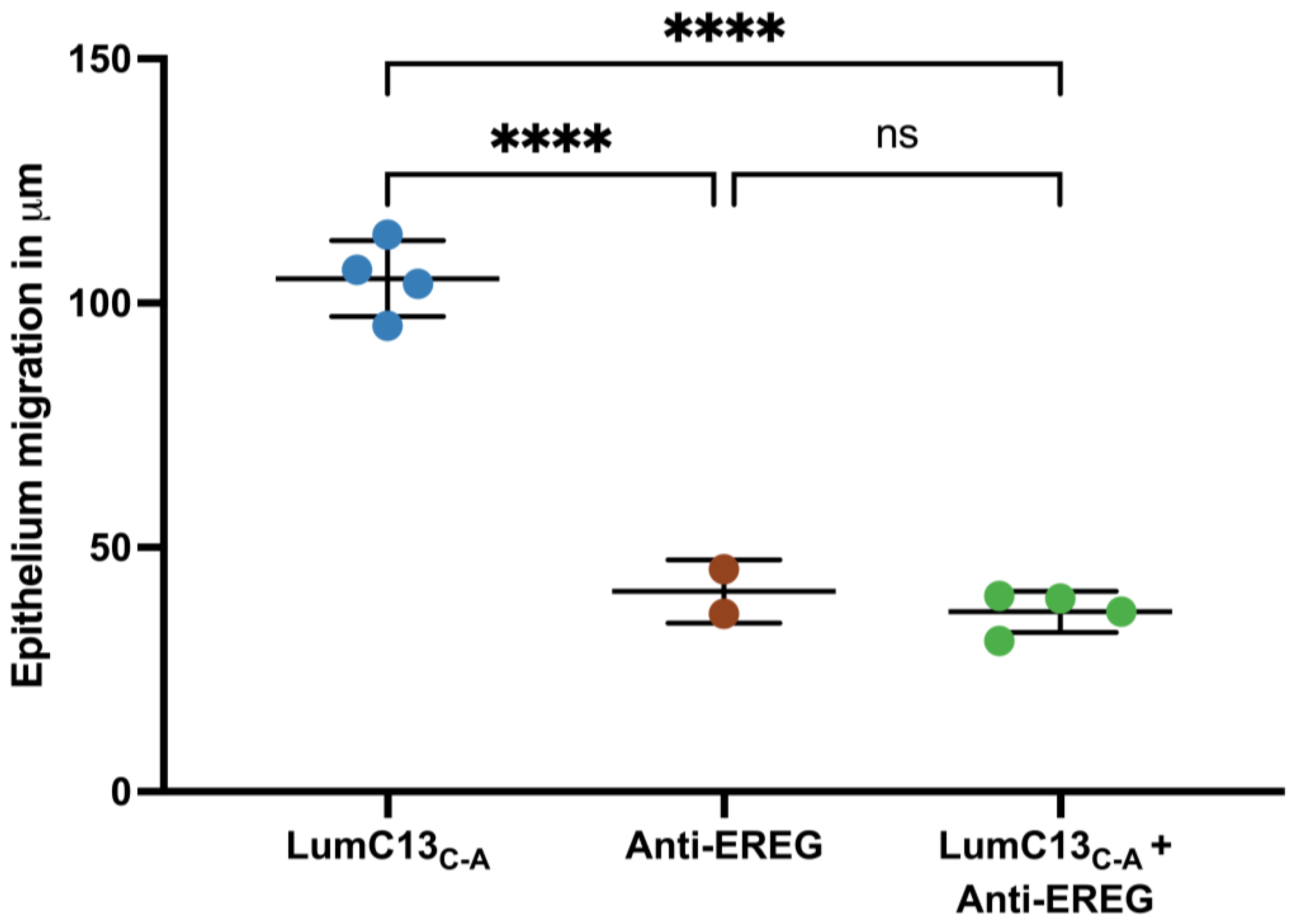
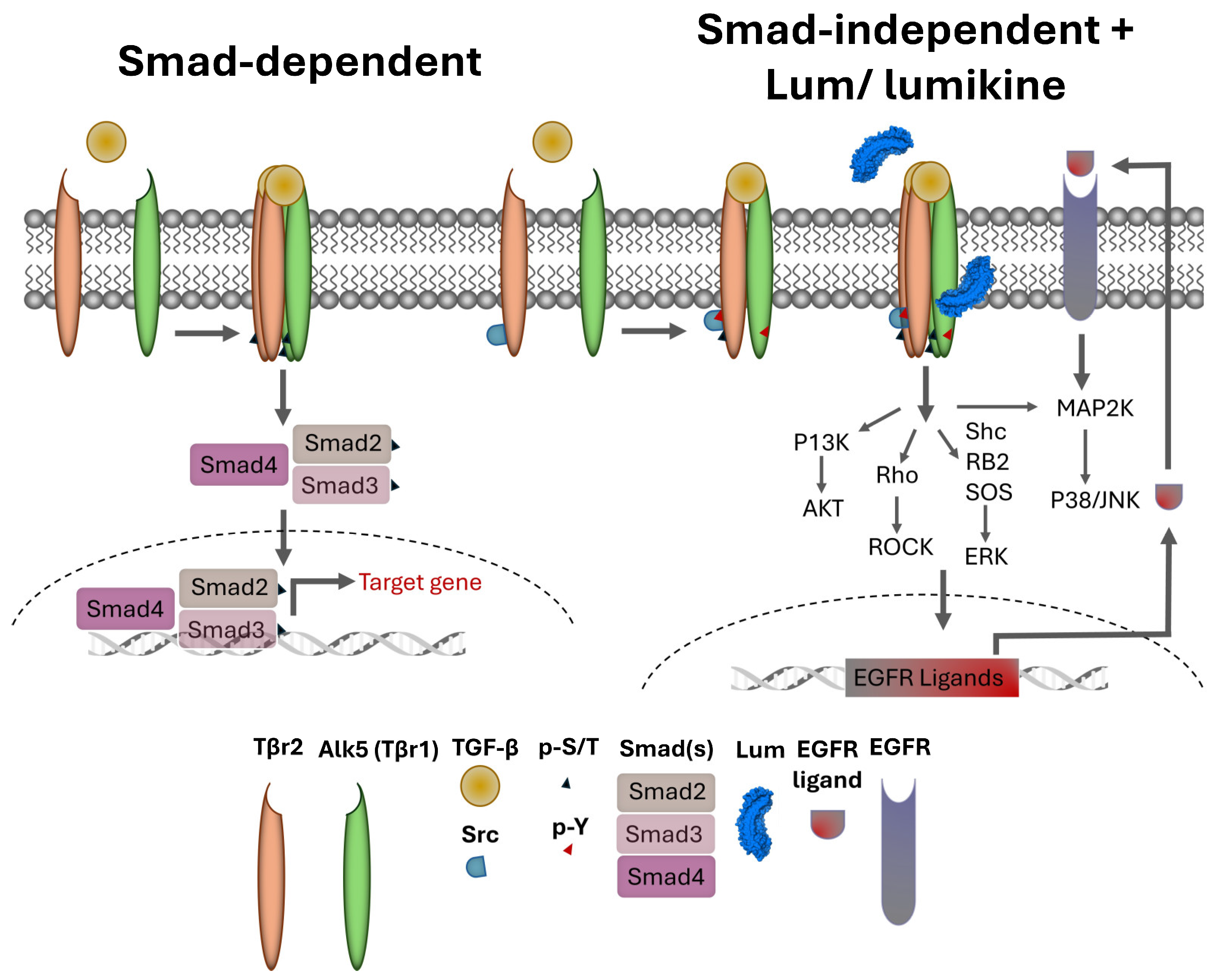
Disclaimer/Publisher’s Note: The statements, opinions and data contained in all publications are solely those of the individual author(s) and contributor(s) and not of MDPI and/or the editor(s). MDPI and/or the editor(s) disclaim responsibility for any injury to people or property resulting from any ideas, methods, instructions or products referred to in the content. |
© 2024 by the authors. Licensee MDPI, Basel, Switzerland. This article is an open access article distributed under the terms and conditions of the Creative Commons Attribution (CC BY) license (https://creativecommons.org/licenses/by/4.0/).
Share and Cite
Kao, W.W.Y.; Zhang, J.; Venkatakrishnan, J.; Chang, S.-H.; Yuan, Y.; Yamanaka, O.; Xia, Y.; Gesteira, T.F.; Verma, S.; Coulson-Thomas, V.J.; et al. Lumican/Lumikine Promotes Healing of Corneal Epithelium Debridement by Upregulation of EGFR Ligand Expression via Noncanonical Smad-Independent TGFβ/TBRs Signaling. Cells 2024, 13, 1599. https://doi.org/10.3390/cells13191599
Kao WWY, Zhang J, Venkatakrishnan J, Chang S-H, Yuan Y, Yamanaka O, Xia Y, Gesteira TF, Verma S, Coulson-Thomas VJ, et al. Lumican/Lumikine Promotes Healing of Corneal Epithelium Debridement by Upregulation of EGFR Ligand Expression via Noncanonical Smad-Independent TGFβ/TBRs Signaling. Cells. 2024; 13(19):1599. https://doi.org/10.3390/cells13191599
Chicago/Turabian StyleKao, Winston W. Y., Jianhua Zhang, Jhuwala Venkatakrishnan, Shao-Hsuan Chang, Yong Yuan, Osamu Yamanaka, Ying Xia, Tarsis F. Gesteira, Sudhir Verma, Vivien J. Coulson-Thomas, and et al. 2024. "Lumican/Lumikine Promotes Healing of Corneal Epithelium Debridement by Upregulation of EGFR Ligand Expression via Noncanonical Smad-Independent TGFβ/TBRs Signaling" Cells 13, no. 19: 1599. https://doi.org/10.3390/cells13191599
APA StyleKao, W. W. Y., Zhang, J., Venkatakrishnan, J., Chang, S.-H., Yuan, Y., Yamanaka, O., Xia, Y., Gesteira, T. F., Verma, S., Coulson-Thomas, V. J., & Liu, C.-Y. (2024). Lumican/Lumikine Promotes Healing of Corneal Epithelium Debridement by Upregulation of EGFR Ligand Expression via Noncanonical Smad-Independent TGFβ/TBRs Signaling. Cells, 13(19), 1599. https://doi.org/10.3390/cells13191599








